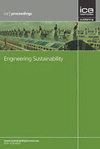可持续预制住宅系统的小规模试验模型研究
IF 1.5
4区 工程技术
Q3 ENGINEERING, CIVIL
Proceedings of the Institution of Civil Engineers-Engineering Sustainability
Pub Date : 2022-04-05
DOI:10.1680/jensu.21.00071
引用次数: 4
摘要
利用未使用的工业废物和对快速体积建筑的需求导致了可持续预制住房元素的发展,特别是对于城市贫民窟。以农工副产品为原料,选用废旧膨胀聚苯乙烯微珠为保温材料,研制了一种轻量化预制构件。该生物灰作为部分替代,20%和10%分别用于细骨料配制混凝土和轻质混合料。一个三分之一比例的小规模模型是按照标准概念化的,包括预制柱和梁作为框架结构,预制板作为墙壁和屋顶元素。这些元素是根据确定的原料的所需混合比例开发的。各自的实验室样品的物理力学,耐久性和热性能进行评估。研究发现,与市售粉煤灰砖的性能相比,开发的墙体最终产品轻27%,强8%,吸水率降低24%,导电性降低62%。太阳能光伏板嵌入到模型的斜屋顶,可容纳其产生的能量的71%,必要的电器。该材料性能满足现场应用要求,最终安装速度比常规方法快20%。本文章由计算机程序翻译,如有差异,请以英文原文为准。
Development of sustainable prefabricated housing system by small-scale experimental model
Utilisation of unused industrial wastes and need for rapid volumetric construction led to the evolution of sustainable prefabricated housing elements, particularly for urban slums. An agro-industrial by-product as raw material and waste expanded polystyrene beads as the insulation material are chosen to develop a lightweight prefabricated construction element. This bio-ash is used as a partial replacement, 20% and 10% for the fine aggregates to prepare concrete and lightweight mix respectively. A small-scale model of one-third scale is conceptualised as per standards that include precast columns and beams as framed structure, and prefab panels as walling and roofing elements. These elements are developed as per the desired mix proportions of the identified raw materials. The respective laboratory specimens are evaluated for the physico-mechanical, durability, and thermal properties. The developed walling end-product is found to be 27% lighter, 8% stronger, 24% less water-absorbent, and 62% less conductive when compared with the properties of commercially available fly-ash brick. A solar photovoltaic panel is embedded into the model’s pitch roof that accommodates 71% of its generated energy to necessary electrical appliances. The material properties are found to be satisfactory for its on-site application and its final erection being 20% faster than conventional method.
求助全文
通过发布文献求助,成功后即可免费获取论文全文。
去求助
来源期刊

Proceedings of the Institution of Civil Engineers-Engineering Sustainability
ENGINEERING, CIVIL-ENGINEERING, CIVIL
CiteScore
3.70
自引率
16.70%
发文量
44
审稿时长
>12 weeks
期刊介绍:
Engineering Sustainability provides a forum for sharing the latest thinking from research and practice, and increasingly is presenting the ''how to'' of engineering a resilient future. The journal features refereed papers and shorter articles relating to the pursuit and implementation of sustainability principles through engineering planning, design and application. The tensions between and integration of social, economic and environmental considerations within such schemes are of particular relevance. Methodologies for assessing sustainability, policy issues, education and corporate responsibility will also be included. The aims will be met primarily by providing papers and briefing notes (including case histories and best practice guidance) of use to decision-makers, practitioners, researchers and students.
 求助内容:
求助内容: 应助结果提醒方式:
应助结果提醒方式:


